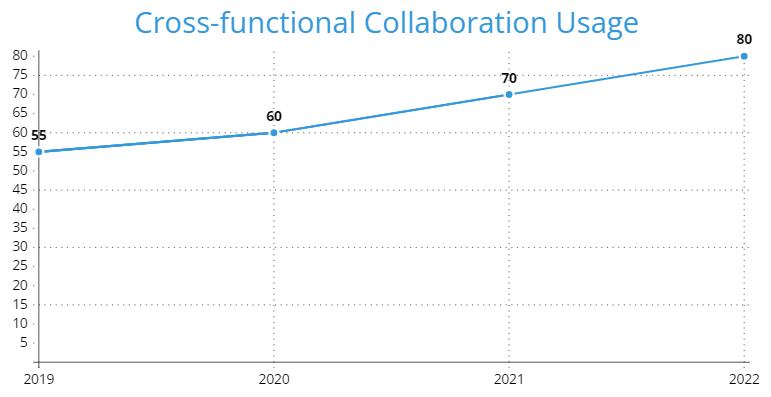In times of disruption functional collaboration becomes a source of innovation and adaptability. According to a Deloitte Insights report, organizations relied on functional work to maintain agility and resilience during the challenging period of the COVID-19 pandemic.
Successful cross-functional collaboration involves aligning departments towards a shared objective. For example, a successful marketing campaign requires efforts, from marketing, sales, design, IT, and other relevant teams.
This effective partnership allows them to tap into a range of perspectives and skills ultimately enhancing the impact of the campaign.
Integrated Communication Platform
An integrated communication platform refers to a software or digital solution that combines communication tools and features into one user-friendly interface. These platforms are created to streamline communication processes within organizations, teams, or projects by bringing together tools, like messaging, video conferencing, email, task management, document sharing, and more. The main objective is to improve collaboration, minimize communication gaps, and enhance productivity.
Interaction in the office is crucial for effective cooperation and performance. In today’s busy service atmosphere, cross-functional groups are becoming a lot more common to take advantage of the varied abilities as well as experiences of workers from various divisions.
Nonetheless, reliable interaction can be an obstacle when groups are expanded throughout numerous areas or functioning from another location. This is where incorporated interaction systems enter play.
In the realm of business communication, Microsoft Teams and Slack emerge as pivotal players by enabling seamless collaboration among team members across distances and merging professional interactions with real-time messaging.
The Microsoft teams slack integration fosters cross-platform communication synergy, combining professional collaboration and instant messaging. Effective communication cultivates trust among team members, guarantees accountability for deliverables, and offers precise role clarity. As opposed to balancing between several applications or devices, an employee can have all their interaction in a solitary system.
Benefits of Integrated Communication Platforms
Here’s how an integrated communication platform can enhance clarity in communication especially when it comes to updates and check-ins for project management for Cross-Functional Workspace:
- Centralized Information: An integrated platform offers a location where all project-related communication, updates, and documents can be accessed. This eliminates the need to search through channels for information. Makes it easier for team members to find the relevant details they need.
- Real-time Communication: Integrated platforms usually provide real-time messaging. Chat features. This allows team members to communicate instantly with each other—asking questions seeking clarifications and sharing updates without any delay typically associated with methods of communication.
- Consistency: By using a platform for all communications it encourages practices in how messages are conveyed. This ensures that everyone involved in the project is on the page and reduces confusion caused by inconsistent approaches.
Consistency plays a role in conveying information and minimizing misunderstandings arising from different communication methods.
- Transparency: It is fostered by enabling project members to view each other’s updates and progress. This not only helps team members stay informed about the status of the project but also promotes accountability.
Integrated platforms often offer features for updates and check-ins. Regular status updates, progress reports, and milestone reviews can be shared in a format that makes it easier for stakeholders to comprehend project developments.
Document-sharing capabilities are commonly included in integrated platforms. This ensures that all relevant project documents are readily accessible and up to date avoiding confusion caused by information.
Task management features are typically integrated into communication platforms. This allows teams to assign tasks, set deadlines, track progress, and update task statuses within a platform eliminating the need to switch between tools.
Trends That Will Shape The Future of Functional Collaboration

1. Virtual Collaboration and Remote Work
With the increasing prevalence of work and virtual collaboration tools, effective communication across functions will be emphasized. Organizations will need to leverage technology to bridge gaps ensuring collaboration among team members regardless of their physical location.
2. Data-Driven Decision Making
The cross-functional collaboration will rely on insights derived from data. By integrating analytics and real-time data sharing teams can make decisions, track progress, and adjust strategies in response to evolving market trends.
3. Focus on Interpersonal Skills
As cross-functional teams continue to include members from different backgrounds there will be a growing demand for skills such as effective communication, empathy, and adaptability. Organizations will invest in training and development programs to enhance these skills.
4. Hybrid Models
A combination of in-person and remote work approaches is likely to become more common as organizations explore models that offer flexibility while maintaining some level of face-to-face interaction.
In order to maintain collaboration effectively we need to come up with strategies that keep both, on-site and remote team members engaged and well-informed.
Essence Of Cross-functional Work

Cross-functional teams consist of individuals from departments who come together with a goal. These teams utilize expertise and viewpoints to generate solutions. On the other hand, cross-functional work refers to the day-to-day activities undertaken by these teams in order to achieve their objectives and carry out projects.
For example, the collaborative efforts between marketing and sales teams to optimize lead generation serve as an illustration of functional work.
According to Deloitte Insights, mature companies are increasingly utilizing functional teams (80%) compared to organizations that are still in the development phase (70%) or early-stage organizations (55%). This trend highlights a decreasing belief that isolated processes impede agility.
However, despite the benefits provided by functional teams they also present challenges. Navigating these challenges is crucial for collaboration, across functions.
Obstacles Hinder Effective Cross-functional Collaboration:
The challenge of communication often arises when team members, with different backgrounds use different terminology and methods resulting in misunderstandings and unclear expectations. To address this, it is essential to establish a vocabulary, set goals, and create a comprehensive communication plan that is accessible to all team members.
The Lack of a System for Recording Information
When important details are scattered across emails, messages, and documents confusion can arise. Implementing platforms can help centralize communication and project management providing a source of truth.”
Mismatched team priorities can lead to tension when key performance indicators (KPIs) are not aligned. It’s crucial to teams with overarching business objectives. Clearly illustrate how their individual efforts contribute to larger goals.
Work Interpersonal Issues
Interpersonal issues often arise due to work styles and communication preferences among team members. To mitigate this problem it’s beneficial to appoint a project leader who will be responsible for decision making and conflict resolution.
Looking ahead as organizations continue to evolve and adapt in the future functional collaboration will only become more critical, for success.
The dynamic nature of the business world calls for adaptability, innovation, and efficient execution. Qualities that are naturally present, in functional teams and their collaborative efforts.
Environment Improvement In Cross-functional Workspace Collaboration
Artificial intelligence and automation will have a role in improving functional collaboration. These technologies can help streamline processes, handle tasks, and even predict obstacles to collaboration.
We will see continued development in the integration of collaboration tools, project management platforms, and communication channels. This integration will create a unified work environment for cross-functional teams.
An increasing emphasis on inclusivity and diversity will also be reflected in functional collaboration. Organizations are recognizing the value of bringing together individuals from backgrounds, cultures, and perspectives to foster innovation and creativity.
Here are some strategies to create an environment of improvement, in functional collaboration:
1. Assessments and Feedback Loops
Conduct frequent evaluations of the functional collaboration processes.
Seek feedback from team members and stakeholders to identify areas that need improvement.
Utilize this feedback to refine communication plans, streamline workflows, and address any emerging challenges.
2. Learning from Mistakes
Recognize that not all cross-functional collaborations will be flawless.
Encourage teams to learn from failures, analyze the root causes, and take measures.
Foster an environment where mistakes are seen as opportunities for growth promoting improvement.
3. Training and Skill Development
Invest in training programs that enhance the skills for cross-functional collaboration.
Provide resources for team members to develop communication, conflict resolution, and project management skills.
Encourage learning to ensure teams remain equipped to handle evolving challenges.
Practices for Successful Cross-Functional Collaboration:
To promote functional collaboration organizations should implement the following practices:
1. Role Assignment – Utilize tools charts to define responsibilities and avoid overlapping roles.
2. Goal Setting for Projects – Ensure teams have measurable and achievable targets using techniques such as SMART goals and OKRs.
Effective Communication Strategies:
1. Establishing Clear Communication Protocols
Create a communication plan that includes meeting schedules, preferred channels of communication (such as Slack, Microsoft Teams, Zoom Chat, or other Slack alternatives), and expectations for response times. This will ensure efficient communication among team members.
2. Ensuring Visibility for Key Stakeholders
Regularly provide status updates to keep leadership informed about the progress of the project. Utilize project management tools that offer real-time visibility into tasks and milestones. Swiftly incorporate feedback from stakeholders to adapt strategies as needed.
3. Fostering a Collaborative Culture
Encourage mindedness. Value diverse viewpoints within the team. Lead by example by demonstrating behavior, actively listening to others and fostering an environment where everyone feels comfortable sharing their ideas. Additionally, organize team-building activities to strengthen collaboration and trust among team members.
4. Providing Support
Regularly assess the effectiveness of collaboration within the team. Proactively address any challenges or issues that arise ensuring conflicts are resolved impartially and fairly. Celebrate milestones achieved along the way and continuously refine processes to enhance teamwork.
FAQs
1. What is the difference between functional teams and cross-functional work?
Cross-functional teams consist of individuals from different departments working together towards a shared objective or goal. It refers to the day-to-day activities performed by these teams in order to achieve their objectives.
2. How can organizations overcome challenges related to communication in functional collaboration?
To overcome poor communication challenges organizations can take several steps;
Establish a shared vocabulary; Define common terms used within the organization to ensure everyone understands each other clearly.
- Define goals: Clearly communicate goals so that all team members are aligned on what needs to be achieved.
- Create an encompassing communication plan: Develop a plan covering aspects of communication accessible to all team members.
This will help improve communication effectiveness, within functional collaborations.
Regular check-ins and maintaining channels of communication also play a role in enhancing collaboration.
3. Why is it crucial to provide visibility to stakeholders in functional projects?
By offering real-time visibility to stakeholders they are empowered to make informed decisions and adjust strategies as necessary ensuring alignment with overall business objectives. Additionally, this practice promotes transparency and fosters a sense of unity among departments.
Conclusion
Cross-functional collaboration empowers organizations to drive innovation, execute initiatives and effectively adapt to disruptions. By addressing communication challenges and adopting industry practices companies can cultivate high-performance cross-functional teams.
With structured processes and transparent practices in place, the outcomes of functional work can significantly elevate business success. Ultimately it’s not about creating a workspace; it’s about nurturing a collaborative ecosystem that propels businesses towards unprecedented levels of achievement.
As businesses continue to navigate through evolving landscapes and emerging technologies the seamless ability to collaborate across departments will remain an asset. This ability drives innovation, and agility and ultimately leads to results.












